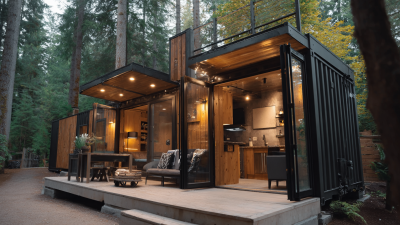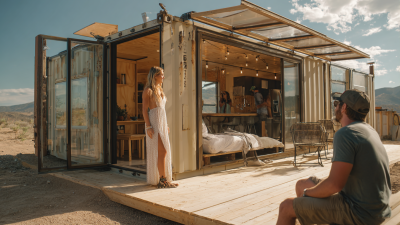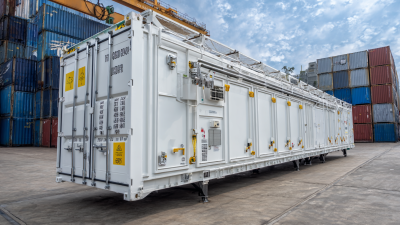Transforming Your Space: Innovative Uses for Empty Shipping Containers
In an era where sustainability and creativity are paramount, the innovative use of empty shipping containers has emerged as a transformative solution for various space challenges. These versatile structures, once confined to the confines of shipping docks, are now being repurposed into stunning homes, vibrant offices, and unique pop-up shops, revolutionizing the way we think about architecture and design. With their modular nature and robust construction, empty shipping containers offer an exciting opportunity to reimagine urban spaces while promoting eco-friendly practices. This article will explore a range of imaginative applications for these containers, providing practical tips and inspiring ideas for anyone looking to embrace this trend. Whether you’re a DIY enthusiast, a business owner, or simply someone looking to enhance their environment, discovering the potential of empty shipping containers can unlock a world of possibilities that are both functional and aesthetically pleasing.

Innovative Shipping Container Homes: Affordable Housing Solutions for Urban Areas
The rise of shipping container homes is revolutionizing the concept of affordable housing in urban areas. As cities face escalating housing costs, these innovative living solutions offer a practical alternative. According to a report by the Urban Land Institute, housing prices in major metropolitan areas have increased by an average of 20% over the last decade, which has pushed many residents toward rethinking their living arrangements. Shipping container homes can reduce construction expenses significantly, with costs averaging between $10,000 and $50,000, depending on the design and modifications needed.
Furthermore, shipping containers are eco-friendly options that promote sustainable living. They can be repurposed rather than discarded, minimizing waste and the carbon footprint associated with traditional building materials. A study from the Sustainable Housing Initiative demonstrates that utilizing shipping containers for housing can reduce energy consumption by 40% compared to conventional homes due to their robust steel construction and potential for efficient insulation. With the ability to stack and arrange containers flexibly, urban planners and developers can create diverse, modular housing solutions that address the unique challenges faced by crowded cities, turning the tide on the affordable housing crisis.
Transforming Your Space: Innovative Uses for Empty Shipping Containers
This chart illustrates the innovative uses of empty shipping containers as affordable housing solutions in urban areas. The data represents various applications in percentage terms.
Repurposing Shipping Containers for Sustainable Retail Spaces: A Market Analysis
Repurposing shipping containers has emerged as an innovative solution for sustainable retail spaces, particularly as the traditional construction sector grapples with economic pressures. As the demand for affordable and flexible commercial spaces increases, developers are creatively transforming these containers into vibrant retail environments. Recent trends indicate that cities are increasingly open to revising building codes, making it easier for projects centered around shipping container utilization to thrive. For instance, shopping plazas featuring ice cream shops and clothing outlets are being established, reflecting a shift towards adaptive reuse in urban settings.

Tips for Implementing Container-Based Retail:
- Research Local Regulations: Stay updated on evolving building codes and zoning laws that govern the use of shipping containers in your area to avoid potential legal issues.
- Focus on Sustainability: Use eco-friendly materials and practices in conjunction with repurposed containers to enhance your brand's appeal and cater to a market increasingly interested in sustainability.
- Create Unique Experiences: Design your retail space creatively to ensure it stands out. Incorporating artistic elements and functional layouts can attract customers and promote a memorable shopping experience.
By leveraging the versatility of shipping containers, retailers can create innovative spaces that meet modern consumer demands while contributing to sustainability efforts.
Transforming Shipping Containers into Mobile Offices: Trends in Remote Work Environments
The rise of remote work has sparked innovative adaptations in various industries, particularly in real estate and workspace design. One striking trend is the transformation of empty shipping containers into mobile offices. As businesses seek flexible and cost-effective solutions for their workforce, shipping containers offer a unique alternative that meets modern demands. According to recent reports, nearly 70% of companies are considering or have implemented hybrid work models, leading to increasing interest in versatile office solutions that can be placed on-site at temporary locations.
In New Zealand, innovative shipping container hire services are powering pop-up workspaces and festivals, catering to the growing trend of remote work environments. Examples from the industry indicate a significant movement towards these portable solutions, with reports showing that the shipment container market is expected to grow by 4.5% annually through 2025. This evolving workspace concept not only supports mobility and flexibility but also emphasizes sustainability by repurposing materials that would otherwise go unused. The adaptability of shipping containers allows for customizable spaces that can be equipped with modern amenities, ensuring productivity in anywhere, anytime settings.

Utilizing Shipping Containers for Urban Farming: Maximizing Space in Cities
Urban farming has gained immense popularity as cities look for sustainable solutions to food production amidst rising population densities. One innovative approach involves repurposing empty shipping containers into functional farming spaces. These metal boxes can be transformed into hydroponic or vertical gardens, providing an efficient way to grow fresh produce right in the heart of urban environments. With proper insulation and climate control systems, these containers can maintain optimal growing conditions year-round.
Moreover, the mobility of shipping containers allows for flexibility in urban design. They can be strategically placed in vacant lots, rooftops, or community spaces, turning underutilized areas into vibrant green hubs. This not only enhances food accessibility but also fosters community engagement as residents participate in the farming process. By utilizing shipping containers, cities can effectively tackle issues related to food deserts while promoting local agriculture, education, and sustainability.
Transforming Your Space: Innovative Uses for Empty Shipping Containers - Utilizing Shipping Containers for Urban Farming: Maximizing Space in Cities
| Feature | Description | Benefits | Example Use Cases |
|---|---|---|---|
| Hydroponics System | Growing plants without soil using nutrient-rich water. | Space-efficient, faster growth rates, reduced water usage. | Urban gardens, community farms, school projects. |
| Vertical Gardening | Utilizing vertical space to grow plants upwards. | Increased yield per square foot, aesthetic appeal. | Rooftop farming, balcony gardening. |
| Climate Control | Insulated containers that maintain optimum temperatures. | Better growth conditions, year-round farming. | Indoor gardening, urban greenhouses. |
| Modular Design | Containers can be used in various configurations. | Flexible space usage, easily expanded or modified. | Pop-up markets, collaborative spaces. |
Creating Pop-Up Restaurants from Shipping Containers: A Growing Trend in Food Service
The trend of creating pop-up restaurants from shipping containers is rapidly gaining momentum, particularly in urban areas where space is at a premium. This innovative approach not only revitalizes unused spaces but also aligns with consumers' shifting dining preferences post-pandemic. As the food truck market, projected to grow at a CAGR of 7.1% from 2025 to 2034, highlights, mobile dining options are increasingly appealing. Shipping container restaurants provide a unique solution that blends mobility with a permanent dining experience, attracting food enthusiasts eager for fresh culinary concepts.
In cities like Long Beach, dining experiences housed in shipping containers are not just trendy; they reflect a growing demand for eco-friendly and diverse food options. As the Australia food service market is set to reach USD 129.9 billion by 2033, fueled by tourism and digital innovation, the repurposed shipping container model supports this growth with lower start-up costs and flexible layouts. This strategy also allows small business owners to tap into local food culture, offering everything from gourmet cuisine to casual fare—all in a compact, attractive setting.
Related Posts
-

Unlocking Value: The Sustainable Benefits of Using Second Hand Storage Containers for Your Home
-

Maximize Your Space: The Rising Trend of Second Hand Storage Containers in Urban Living
-

Exploring the Future of Sustainable Living with Container Cabins
-

Transform Your Space: The Rise of Shipping Containers for Storage and Their Eco-Friendly Benefits
-

Unlocking the Future of Sustainable Living through Innovative Container Conversions
-

Understanding Container Insulation: The Key to Energy Efficiency in Shipping and Storage

